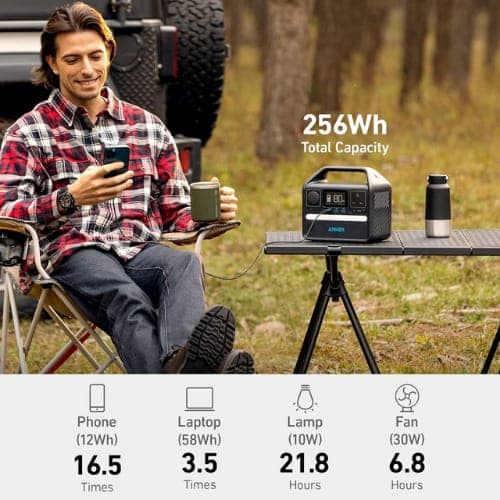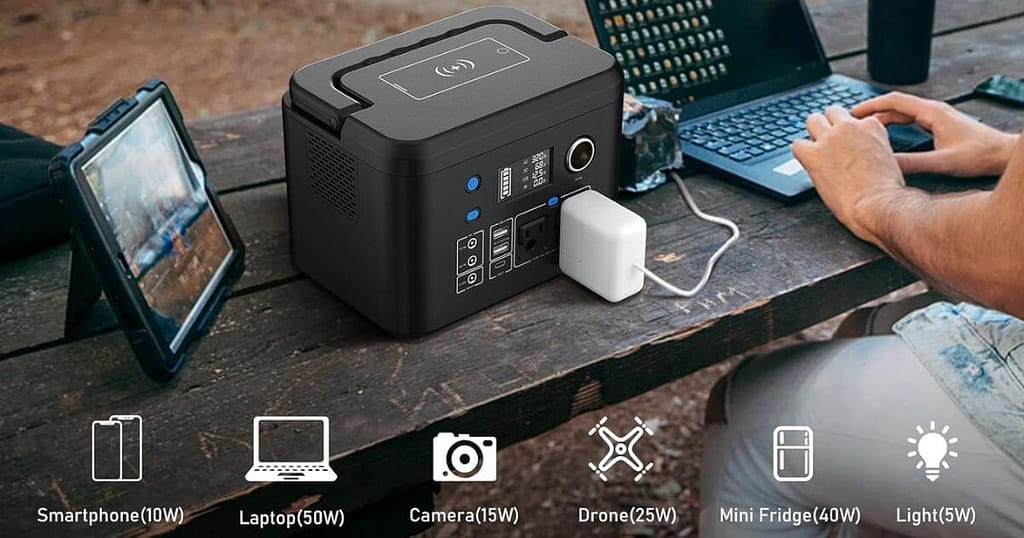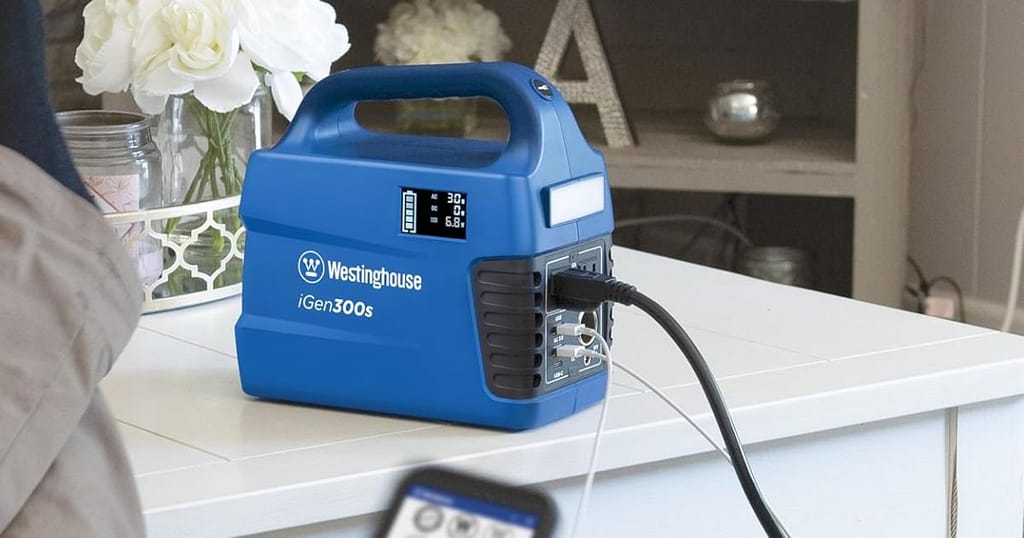When it comes to staying powered up while on the go, having a portable and reliable power source is a must. Whether you’re camping, taking work trips, or need backup power during emergencies, being able to charge your devices without an outlet is invaluable.
After hearing great things about Anker’s portable power stations, I decided to pick up their Anker 521 Portable Power Station to test out myself. As someone who spends a lot of time away from home and needs consistent access to power, I was curious to see if this compact battery could keep up with my mobile needs
Over the past few months, I’ve taken the Anker 521 with me on various trips and assignments to put it through its paces. From charging phones, drones, and laptops while camping, to using it for emergency backup amid power outages, this battery has proven itself time and again.
In this review, I’ll share my real-world experience using the Anker 521 solar generator – the pros I’ve discovered, any limitations it has, and who it will work best for. By the end, you’ll have a thorough understanding of whether this portable power station is the right portable power solution for your lifestyle and needs.
So without further ado, let’s dive into my honest Anker 521 Portable Power Station review.
Anker 521 Portable Power Station Review
LiFePO4 Battery
The Anker 521 Portable Power Station is an impressive device that offers durability and longevity, thanks to its innovative InfiniPower technology. This technology incorporates lithium iron phosphate (LiFePO4 or LFP) batteries, which are known for their long-term stability and performance compared to standard lithium-ion (Li-ion) batteries. These LFP batteries are rated for over 3000 charge cycles, which means that the Anker 521 can be fully charged and drained daily for more than eight years without any significant loss in its capacity.
In addition to the long-lasting batteries, the Anker 521 also features ultra-durable electronics and a control system that monitors the temperature up to 100 times per second. This ensures that the device maintains its optimal performance by preventing overheating and other temperature-related issues. Moreover, the power station has an impact-resistant build, which further contributes to its overall durability.
Anker is confident in the longevity of its 521 Portable solar Power Station, claiming that it is designed to last for 10 years even with daily use. To back up this claim, the company offers a five-year warranty, giving customers peace of mind and assurance in their investment.
Display
The Anker 521 Portable Power Station features a mini-LCD display that provides useful information about the device’s status and performance. This includes the current battery status, the amount of power being drawn from the station, and an estimate of the remaining time until the station is fully charged. The display is easy to read and helps users keep track of the station’s performance and capacity.
In addition to these general statistics, the display can also show specific details about the connected devices. For example, when a laptop is connected to the power station, the display will show the laptop’s power consumption in watts. This feature is particularly helpful for users who want to monitor their device’s energy usage and manage their power consumption more efficiently.
Overall Design

The Anker PowerHouse 521 is a compact and portable power station that is an excellent solution for charging various devices. Despite its relatively small size, similar to that of a toaster, it packs a punch with its array of output ports. The power station weighs 3.7 kilograms, which is fairly light considering the amount of power it can hold.
The Anker 521 Portable Power Station features two USB-A ports, one USB-C port, a 12V car-type (cigarette) port, and a single AC socket. The USB-A ports have a maximum output of 12W, while the USB-C port supports USB Power Delivery (USB PD) up to 60W. This is enough power to charge smaller laptops and other USB-C devices. The car outlet has a maximum output of 120W, and the AC socket can provide up to 200W of power. This is sufficient for charging laptops and other small devices, although it may not be powerful enough to handle more energy-intensive appliances like coffee machines.
How it Can Be Charged?

When it comes to charging up my trusty Anker 521 portable power station, I’ve got plenty of options depending on my situation.
First up, the included power adapter is probably the most straightforward way to juice it up. At 65 watts, it packs a decent punch. I simply plug it into the port on the back of the unit, then into any regular wall outlet. Anker says it’ll take about 4 hours to fill it all the way using this method – not too shabby.
Now, when I’m on the go, the car adapter is a lifesaver. Even if I’m just taking a road trip or have to wait in the car, I can plug into the 12V socket and keep things charged up without draining my car’s battery. Just need to remember that it uses that same charging port, so you can’t hybrid charge or anything fancy. But it gets the job done.
One feature I really love is that it works with solar panels. On long camping trips off the grid, being able to slap one of Anker’s 100W panels on the back and let good old Sol power my Anker portable power station has been incredible. In my experience, even if the panel isn’t perfectly angled, it still pulls in around 63 watts which is plenty to fully replenish the battery in under 5 hours. Talk about renewable energy!
And for a faster re-up sometimes, the USB-C port is great too. At 60 watts, Anker says it cuts the charging time down to about 2.5 hours when used with a compatible wall charger. Great for when you’re in a pinch.
Overall, I’m seriously impressed by the versatility of charging options on this thing. It really lets me take advantage of whatever power source is available to me and has been a trusted companion no matter where my adventures take me.
How many tools Can the Anker 521 generator run?

One important thing to keep in mind with portable power stations like my Anker 521 Portable Power Station is that they have limitations in terms of how much power can be drawn from the battery at once.
This little unit has a maximum limit of 200 watts – so anything drawing more than that simply won’t work as the battery wouldn’t be able to handle the overload. Anker does make some bulkier and pricier models that allow for higher-wattage devices though.
Something a newb like me had to learn too was that sometimes gadgets have different starting power needs versus continuous running needs. For example, something could run fine on 150w but might spike up to 500w briefly at startup. Since power stations like a cap on max power output to protect the battery, that startup spike could cause it to automatically shut off before the device even gets going.
So with my Anker 521 portable power station, there’s no way I could plug in something huge like an electric space heater. But it works great for powering lighter loads, like charging phones/laptops. Just be aware that some higher-end gaming laptops could potentially push above the 200w limit under a serious gaming load. It probably wouldn’t be safe to run one continuously off the Anker in that case.
On the plus side, stuff like projectors, WiFi routers, electric tools, and more are perfectly within its limits. I’ve even been able to run a small projector outside on camping trips to watch movies without needing a house outlet. Overall it’s amazing the versatility this compact little powerhouse provides, as long as you stay within its max output specs.
If you need more power then you may consider its following big brother:
Pros:
- One of the best portable power station in 2024
- Easy to carry for long distance due to smart design
- Ideal choice for camping to power small tools and devices
- High technology battery
Cons:
- Not sufficient to power large size tools
Only limited usage
My Final Thoughts
Overall Rating: 4.5/5.00
After using my Anker 521 portable power station for a while now, here are my overall thoughts:
It’s served me really well for lighter tasks when full off-grid power isn’t required. Its modest capacity does have limitations, so this isn’t something I’d rely on as a full home backup power source during an emergency. But for what it is – a portable and compact battery pack – it gets the job done nicely.
If heavy loads are a priority, the larger Bluetti EB3A might be a better call. But for my needs of keeping phones, laptops, and smaller electronics juiced on camping trips or work projects away from an outlet, the Anker has been totally sufficient.
I’ve found it holds charges nicely between uses and stands up to bumps and drops without issue. The integrated LED flashlight is a nice value-add too. My favorite feature though has been pairing it with Anker’s 625 solar panel – on sunnier days it’ll often keep recharging itself so the power just keeps flowing.
Ultimately it’s not the most heavy-duty portable power source out there, but for modest mobile power needs, compact design, and simplicity, I think the Anker 521 delivers great value and reliability. It’s become an indispensable tool in my toolkit for any time I need to stay powered up off the grid.
FAQs
How long does it typically take for the Anker 521 Portable Power Station to fully charge?
The charging time for the Anker 521 Portable Power Station may vary depending on the power source used. When using a wall outlet, it takes approximately 2-3 hours to fully charge the power station. If you are using a solar panel, the charging time may take longer, depending on the panel’s wattage and the availability of sunlight. It is important to note that the charging time can be affected by factors such as temperature and the number of devices connected to the power station. However, in general, it takes around 3-4 hours to fully charge the Anker 521 Portable Power Station using a wall outlet.
Recommended Portable Power Stations:





